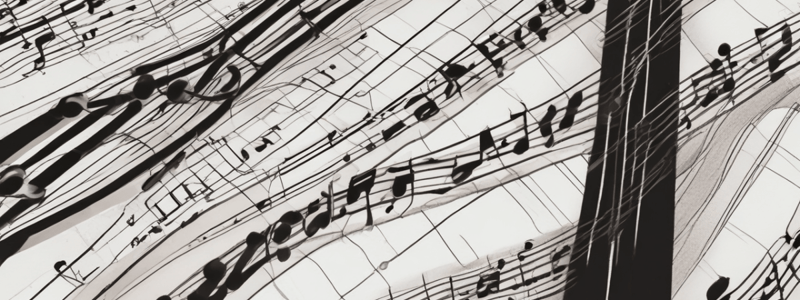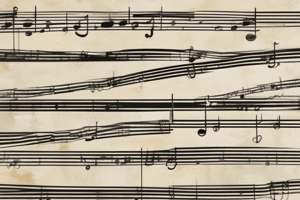Podcast
Questions and Answers
What is the primary purpose of understanding the natural, harmonic, and melodic minor scales in minor key signatures?
What is the primary purpose of understanding the natural, harmonic, and melodic minor scales in minor key signatures?
- To understand musical theory (correct)
- To create a sense of tension and resolution
- To appreciate the relationship between different scales
- To compose musical pieces
What is the formula for constructing a natural minor scale?
What is the formula for constructing a natural minor scale?
- Half step, half step, whole step, whole step, half step, whole step, whole step
- Whole step, whole step, whole step, half step, whole step, half step, whole step
- Whole step, half step, whole step, whole step, half step, whole step, whole step (correct)
- Half step, whole step, half step, whole step, half step, whole step, whole step
What is the main difference between the natural and harmonic minor scales?
What is the main difference between the natural and harmonic minor scales?
- The third note is raised by a whole step
- The fifth note is lowered by a half step
- The sixth note is raised by a half step
- The seventh note is raised by a half step (correct)
What is the characteristic of the melodic minor scale when ascending?
What is the characteristic of the melodic minor scale when ascending?
What is the importance of the natural minor scale in music theory?
What is the importance of the natural minor scale in music theory?
What is the characteristic of the harmonic minor scale?
What is the characteristic of the harmonic minor scale?
What is the purpose of the melodic minor scale?
What is the purpose of the melodic minor scale?
What is the result of raising the seventh note by a half step in the harmonic minor scale?
What is the result of raising the seventh note by a half step in the harmonic minor scale?
What is the primary goal of modulation in music composition?
What is the primary goal of modulation in music composition?
When is direct modulation more suitable?
When is direct modulation more suitable?
What is the best way to develop your skills in modulation?
What is the best way to develop your skills in modulation?
Why is it crucial to maintain coherence and musicality throughout transitions?
Why is it crucial to maintain coherence and musicality throughout transitions?
What is the role of modulation and key changes in music composition?
What is the role of modulation and key changes in music composition?
What is the purpose of understanding the patterns and order of sharps and flats in minor key signatures?
What is the purpose of understanding the patterns and order of sharps and flats in minor key signatures?
What is modulation in music?
What is modulation in music?
What is the benefit of modulating to different keys in music?
What is the benefit of modulating to different keys in music?
What is the importance of establishing a solid foundation in the original key before modulating?
What is the importance of establishing a solid foundation in the original key before modulating?
What is direct modulation?
What is direct modulation?
What is the circle of fifths used for in music?
What is the circle of fifths used for in music?
What is the purpose of secondary dominants in music?
What is the purpose of secondary dominants in music?
What is chromatic modulation?
What is chromatic modulation?
Why is it important to use modulation strategically in music?
Why is it important to use modulation strategically in music?
What is the benefit of recognizing modulation in music?
What is the benefit of recognizing modulation in music?
What is the relationship between the natural minor scale and the relative minor key of a major key signature?
What is the relationship between the natural minor scale and the relative minor key of a major key signature?
What is the purpose of the harmonic minor scale?
What is the purpose of the harmonic minor scale?
What is the pattern of whole and half steps in the natural minor scale?
What is the pattern of whole and half steps in the natural minor scale?
What is the purpose of the melodic minor scale?
What is the purpose of the melodic minor scale?
How many flats are in the key signature of C minor?
How many flats are in the key signature of C minor?
What is the order of sharps in minor key signatures?
What is the order of sharps in minor key signatures?
What is the purpose of accidentals in music?
What is the purpose of accidentals in music?
What is the relationship between the ascending and descending forms of the melodic minor scale?
What is the relationship between the ascending and descending forms of the melodic minor scale?
How many sharps are in the key signature of E minor?
How many sharps are in the key signature of E minor?
What is the purpose of understanding the natural, harmonic, and melodic minor scales?
What is the purpose of understanding the natural, harmonic, and melodic minor scales?
Flashcards
Natural Minor Scale
Natural Minor Scale
A fundamental scale in music built using a specific formula of whole steps (W) and half steps (H). The formula is: W - H - W - W - H - W - W.
Harmonic Minor Scale
Harmonic Minor Scale
A variation of the natural minor scale used in harmony to create a stronger sense of tension and resolution. The seventh note is raised by a half step.
Melodic Minor Scale
Melodic Minor Scale
Another variation of the natural minor scale, used primarily in melodic passages, especially when ascending. The sixth and seventh notes are raised by a half step in the ascending form, but revert to the natural minor scale when descending.
Natural Minor Scale in Key Signatures
Natural Minor Scale in Key Signatures
Signup and view all the flashcards
Harmonic Minor Scale in Key Signatures
Harmonic Minor Scale in Key Signatures
Signup and view all the flashcards
Melodic Minor Scale in Key Signatures
Melodic Minor Scale in Key Signatures
Signup and view all the flashcards
Minor Key Signatures
Minor Key Signatures
Signup and view all the flashcards
Sharps in Minor Key Signatures
Sharps in Minor Key Signatures
Signup and view all the flashcards
Flats in Minor Key Signatures
Flats in Minor Key Signatures
Signup and view all the flashcards
Modulation
Modulation
Signup and view all the flashcards
Modulation in music
Modulation in music
Signup and view all the flashcards
Identifying Modulation
Identifying Modulation
Signup and view all the flashcards
Preparing for Modulation
Preparing for Modulation
Signup and view all the flashcards
Direct Modulation
Direct Modulation
Signup and view all the flashcards
Gradual Modulation
Gradual Modulation
Signup and view all the flashcards
Circle of Fifths
Circle of Fifths
Signup and view all the flashcards
Secondary Dominants
Secondary Dominants
Signup and view all the flashcards
Chromatic Modulation
Chromatic Modulation
Signup and view all the flashcards
Strategic Modulation
Strategic Modulation
Signup and view all the flashcards
Modulation Timing
Modulation Timing
Signup and view all the flashcards
Modulation Experimentation
Modulation Experimentation
Signup and view all the flashcards
Leading Tone
Leading Tone
Signup and view all the flashcards
Key Signature
Key Signature
Signup and view all the flashcards
Tonic
Tonic
Signup and view all the flashcards
Tonality
Tonality
Signup and view all the flashcards
Study Notes
Natural Minor Scale
- The natural minor scale is a fundamental scale in music theory, built using a specific formula of whole steps (W) and half steps (H).
- The formula for constructing a natural minor scale is: whole step, half step, whole step, whole step, half step, whole step, whole step.
- Example: A natural minor scale is A - B - C - D - E - F - G - A.
Harmonic Minor Scale
- The harmonic minor scale is a variation of the natural minor scale, used in harmony to create a stronger sense of tension and resolution.
- The main difference between the natural and harmonic minor scales lies in the seventh note, which is raised by a half step in the harmonic minor scale.
- Example: A harmonic minor scale is A - B - C - D - E - F - G# - A.
Melodic Minor Scale
- The melodic minor scale is another variation of the natural minor scale, primarily used in melodic passages, especially when ascending.
- The ascending form of the melodic minor scale raises both the sixth and seventh notes by a half step compared to the natural minor scale.
- The descending form of the melodic minor scale reverts back to the notes of the natural minor scale.
- Examples: A ascending melodic minor scale is A - B - C - D - E - F# - G# - A, and the descending form is A - G - F - E - D - C - B - A.
Relation to Minor Key Signatures
- The natural minor scale corresponds to the relative minor key of a major key signature.
- The harmonic minor scale is used in harmonic progressions or chords that require the leading tone, which is the raised seventh note found in this scale.
- The melodic minor scale is utilized during melodic passages and solos.
Sharps and Flats in Minor Key Signatures
- Minor key signatures have specific patterns that determine which notes are altered.
- Key signatures with flats follow a consistent pattern, with a specific number of flats depending on the key.
- Key signatures with sharps also follow a consistent pattern, with a specific number of sharps depending on the key.
- The order of sharps is F#, C#, G#, D#, A#, E#, B#, and the order of flats is Bb, Eb, Ab, Db, Gb, Cb, Fb.
Modulation
- Modulation in music refers to the technique of changing the key of a musical piece, adding depth, variety, and emotional impact to the composition.
- Modulation involves transitioning from one key to another, which can create tension and release, highlight different musical themes, and provide a sense of progression.
Understanding Modulation
- Modulation can occur at any point in a musical piece and may involve different levels of complexity.
- Identifying modulation in music requires attentive listening and an understanding of musical context.
- Some common indicators of modulation include changes in tonality, shifts in harmony, alterations in melody, and variations in chord progressions.
Preparing for Modulation
- Mastering the original key allows for a seamless transition to the new key and maintains musical coherence.
- Familiarize yourself with the key signature, chord progressions, and melodic patterns of the current key.
Types of Modulation
- Direct Modulation: Shifting abruptly from one key to another through a common chord or pivot chord.
- Gradual Modulation: Introducing the new key more subtly through a series of chords or harmonies that connect the original key to the new key.
Common Modulation Techniques
- Circle of Fifths: A tool used by composers to navigate between closely related keys.
- Secondary Dominants: Chords that lead to a chord other than the tonic, allowing for modulation to other keys within a composition.
- Chromatic Modulation: Changing keys using chromatic movement, creating a sense of harmonic tension and facilitating a smooth transition to the new key.
Tips for Successful Modulation
- Use modulation strategically to serve the overall musical composition.
- Gradual modulation is generally more suitable for longer compositions, while direct modulation can add a punch or surprise in shorter pieces.
- Experiment with different techniques and progressions to find the modulation that best fits your musical ideas.
Studying That Suits You
Use AI to generate personalized quizzes and flashcards to suit your learning preferences.
Description
Understand the relationship between natural, harmonic, and melodic minor scales in minor key signatures and their importance in musical composition.



